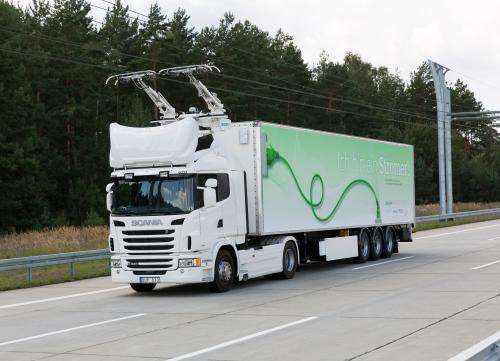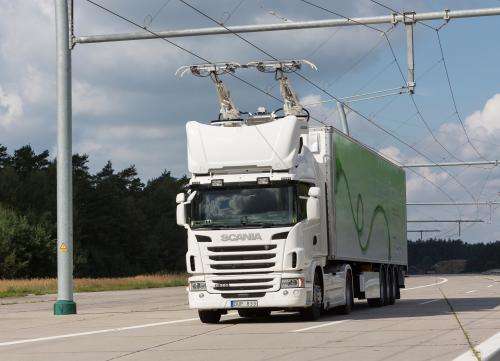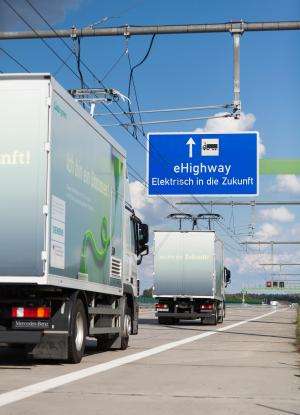Trucks to drive with current collectors on a public road for the first time

Trucks will soon drive with current collectors on a public road for the first time, thanks to overhead cables that Siemens is installing for electric and hybrid trucks in Carson, California. Up to four test trucks will be supplied with electricity in both directions, enabling them to travel along the two-mile eHighway system without producing any emissions. The technology will be tested in practice until mid-2016. Siemens is running the project in cooperation with Volvo Group's Mack Trucks subsidiary and the conversion specialist Transpower.
According to experts, freight traffic will increase threefold by 2050. As a result, far more trucks will be on the road in the future, despite the expansion of railways. Thousands of trucks already travel to the ports of Los Angeles and Long Beach every day. A 30-kilometer-long section of road is especially congested, with around 35,000 trucks traveling along it every day. Because the number of vehicles along this route is expected to increase almost threefold by 2035, the port authorities are looking for a zero-emission transportation solution. That's why the South Coast Air Quality Management District (SCAQMD) now wants to determine whether the eHighway system is suited for commercial use along Interstate I-710. The test trucks can also be integrated into shipping companies' fleets under real-life conditions.
The eHighway system is an energy-efficient, low-emission solution that was developed by Siemens for heavily used truck shuttle routes. The system encompasses overhead cables for roads as well as electric or hybrid trucks fitted with intelligent current collectors. Sensors on the vehicles' roofs recognize whether there is an overhead cable and can automatically connect or disconnect the truck from the cable. They also enable the trucks to change lanes in order to overtake other vehicles at speeds of up to 90 kilometers per hour. The trucks do not produce any local emissions if an overhead cable is available. On conventional stretches of road, the trucks switch to diesel, natural gas, or battery-electric operation, depending on the drive system they are equipped with. With an efficiency of around 80 percent, the eHighway system is about twice as efficient as a diesel truck, thanks to the higher efficiency of electric drives. Moreover, overhead cables transmit electricity with 99 percent efficiency. The eHighway system's energy efficiency is further increased by the fact that the trucks feed electric braking energy back into the grid.
Siemens has been developing the eHighway system since 2011 as part of the ENUBA research project. In 2011, Siemens used diesel-electric trucks to demonstrate the concept's feasibility on a test track. The project partners of ENUBA 2 are currently investigating the technology's suitability for everyday use. Among other things, they are conducting curve tests and examining solutions that would allow the technology to be integrated into tractor units for pulling conventional semi-trailers. In California, the eHighway system is now being installed on public roads for the first time, where it will be tested with a variety of truck drives - battery-electric, diesel-electric, and natural gas-electric.
-

In the follow-up project, ENUBA 2, Siemens entered into a partnership with Scania, a Swedish company. The focus is on optimizing the integration of the drive system and pantograph into the vehicle and on providing the necessary traffic control systems. The picture shows a driving scene at the extended eHighway test track in Groß Dölln, Germany. -

In the follow-up project, ENUBA 2, Siemens entered into a partnership with Scania, a Swedish company. The focus is on optimizing the integration of the drive system and pantograph into the vehicle and on providing the necessary traffic control systems. The picture shows a driving scene at the extended eHighway test track in Groß Dölln, Germany
Provided by Siemens



















